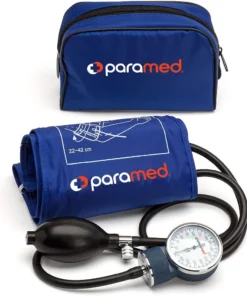
Stay healthy and make the most of your days with reliable blood pressure measurements!
 .
.
How to use the calibration key.
The kit includes a small key that fits into the air-guard opening of the manometer. Carefully rotate the key sideways according to what is needed. Please note that turning the key clockwise moves the arrow to the left, and vice versa. This key is for adjusting slight move of manometer needle. Adjustment range: 6mmHg from center of zero position.
- Small key cannot be turned full circle of manometer. Otherwise, mechanism will be damaged.
Manual Blood Pressure Cuff by Paramed is made from quality materials for people who value accuracy. Please note that there is no stethoscope in this model.
The high-quality materials also include sturdy hardware like the steel D-ring on the blue cuff, the metal body on the manometer, which is made of zinc alloy, and the premium Velcro on the cuff.
This blood pressure measuring kit includes all the necessary components:
- Sphygmomanometer;
- Cuff;
- Bulb and Valve;
- Carry bag;
- Calibration key;
- User manual.
Product benefits
|
|
|
|
|
|---|---|---|---|
Quality materialsThe pressure gauge of our device is made of high quality zinc alloy. And the velcro fastener perfectly fixes, does not unfasten at the maximum mode of air injection. Therefore, the device will serve you for a long time. |
Comfortable cuffManual Blood Pressure Cuff by Paramed has a comfortable cuff 16 inch long. This means that people of any stature can measure pressure without problems. The cuff is designed for daily use and multiple measurements. |
Standard D-Ring CuffA D-ring cuff is a cuff in which the user passes through one end of the cuff through a metal ring and then attaches it to the arm. Cuff adjustment is easily done using this stainless steel ring. |
Clip for a cuffThe manometer has a special fastening tool so that you can attach it in a place that’s comfortable for you. It’s convenient for the readout to be at eye level so that you can carefully monitor the pressure gauge. |

How to use a sphygmomanometer correctly
|
|
|
|
|
|---|---|---|---|
Put the cuffPut the cuff on your left arm 2-3 cm (~1 inch) above your elbow. Cuff’s tubes should run along the center of your arm. Wrap the cuff around your arm so that you can fit one finger between the cuff and your arm, and attach it with Velcro. |
Place the stethoscopePut the stethoscope (you will need to obtain one separately) on. Make sure that the earpieces are facing forward. If you put them in backwards, you won’t be able to hear anything. Place the head on your humeral artery a bit above the elbow joint facing the body where the artery usually runs. You can secure the stethoscope using the cuff. |
Pump airQuickly fill the cuff with air until it reaches your typical upper pressure reading with an additional 30 mmHg. Then, stop pumping in air. Start letting air out of the cuff so that the manometer’s arrow descends 2-3 marks per second. |
Listen to Korotkoff soundsNote the pressure when you first hear your heartbeat. This is the upper, or systolic, pressure number. Note the pressure when the sound stops. This is the lower, or diastolic, pressure number. We recommend writing down your measurements, which will help you and your doctor analyze your health. |
Factors that may affect the real values of the arterial blood pressure
| Cuff is too small | Increase in systolic blood pressure to 10–40 mmHg. |
| Cuff used over clothing | Clothing can impact a systolic blood pressure from 10 to 50 mmHg.1111 |
| Not resting 3-5 minutes | Exercise or eating can affect your systolic blood pressure measurement 10 to 20 mmHg. |
| Arm/Back/Feet Unsupported | Diastolic blood pressure measurement may be increased by 4 to 8 mmHg. |
| Talking | Systolic blood pressure measurement may increase 10 to 15mmHg. |
| Full bladder | Systolic blood pressure measurements could increase 10 to 15mmH |













Reviews
There are no reviews yet.